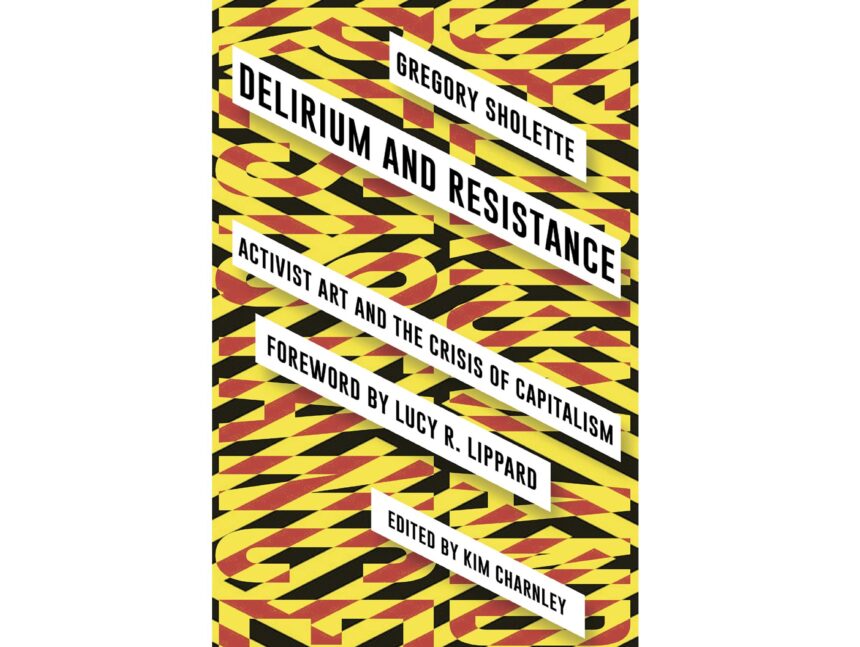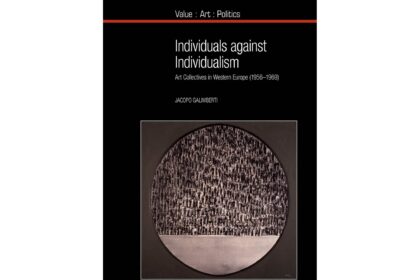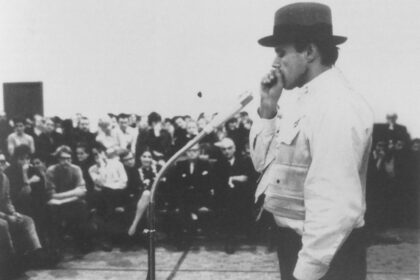Book Review: Gregory Sholette, Delirium and Resistance: Activist Art and the Crisis of Capitalism, edited by Kim Charnley; foreword by Lucy R. Lippard (London: Pluto Press, 2017)
Noni Brynjolson
In our current political environment, words like ‘conflict,’ ‘turmoil’ and ‘disaster’ seem to have become more common. Our everyday vocabulary has shifted: ‘nuclear war’ saw a surge of internet searches during the summer of 2017, and continues to be frequently searched following Trump’s election, according to a Google trends analysis. It is no surprise to learn that searches for the words ‘radical,’ ‘polarized’ and ‘divided’ have all reached ten-year highs, as have ‘racism’ and ‘white nationalism’. ‘Trump’ + ‘apocalypse’ saw a spike in searches in May 2016 following his victory in the primaries, as well as on election night in November 2016 (‘move to Canada’ produces a similar chart).[1] Although words like ‘crisis’ have been used by political and social commentators throughout the twentieth century, a sense of division and chaos has unquestionably left its mark on contemporary public discourse, and discussions of the latest spectacle or tweet seem to have become inescapable in everyday conversation.
Gregory Sholette’s book Delirium and Resistance: Activist Art and the Crisis of Capitalism puts this moment of crisis into context, and looks at how artists and activists have reacted to similar anxieties over the past several decades. Most of the essays were written and published before Trump was elected (including the essay “Delirium and Resistance: After the Social Turn,” published in FIELD’s first issue), and the book’s emphasis on crisis and the questions it raises about the divisions underlying the contemporary public sphere seem prescient. It consists of a collection of essays that focus on different historical moments throughout Sholette’s career as an artist, activist and writer, including examples of activist art from the 1970s up to the socially engaged art of the past decade. Many of the essays invite questions about the forms of resistance enacted by this type of work, as well as its limitations and failures, at a time when it often feels as if the gains of past social movements are slipping away.
Delirium and Resistance includes a foreword by Lucy Lippard and an introduction by Kim Charnley, who also edited the book. The essays are divided into three sections: ‘Art World,’ ‘Cities Without Souls’ and ‘Resistance,’ each framed by additional introductions by Sholette, which provide interesting forms of writerly self-reflection. At one point, he recalls working as a late-night janitor at a computer hardware factory to pay for community college classes, an experience that taught him first-hand about class stratification.[2] The introductions also serve as reflections on the cyclical nature of social movements and progressive politics, as he wonders “what forms of oppositional praxis are opened up, or closed down by the changing conditions of artistic production over time.”[3]
While the book takes on new meanings in light of current political events, its main focus is to reflect on the economics of art under neoliberal capitalism. Sholette refers to this as bare art, borrowing from Agamben, who defined bare life as the condition of bodies reduced to biological existence through being excluded from the category of political citizenship by the state. For Sholette, bare art refers to art’s reduction to pure commodity status within capitalist modes of exchange–there is no longer a protective zone of aesthetic autonomy that exists outside of enterprise culture.
One argument that emerges repeatedly throughout the various essays in the book is that social change is possible, but only by harnessing the power of resistance from below, and heeding the lessons of past activist movements. The importance of learning from the past comes up in “Counting on Your Collective Silence,” in which Sholette examines the minutes of three politically engaged art collectives from New York to examine how they negotiate their internal politics.[4] He points out that “each new group tends to reinvent organizational processes already attempted, sometimes even abandoned by other similar institutions,” and are naturally inclined to do so because of a distrust of establishment politics.[5] He discusses the film The Matrix, and the metaphor of the blue pill versus the red pill—the former allows blissful ignorance, while the latter opens one’s eyes to reality. In the context of activist art, he suggests that taking the red pill opens up one’s eyes to the fiction of individual genius, but also to the fragmented nature of reality and the “jagged heaps of partial meanings and chunks of resistant histories left over from communal aspirations and failures.”[6] It is worth noting that the term ‘redpill’ has been taken up by the alt-right in recent years (its Google search popularity peaked in February 2017). To redpill someone, according to this worldview, might mean to open their eyes to the supposed truths of men’s rights activism or white nationalism; ‘redpilled’ is thereby the polar opposite of ‘woke.’ The alt-right has been extremely successful in spouting their ideas through viral, often nihilistic memes that influence public opinion, or at least a subset of it, and these different interpretations of the red pill metaphor point to the battles that are taking place, on- and offline, over competing views of truth and reality.
This increasing sense of division and polarization relates to the theme of crisis that comes up repeatedly throughout the book. Numerous examples demonstrate how political and economic crises have been perceived, made visible, and then acted upon through various tactics of resistance by artists. In considering these cycles, Sholette also points to the ways in which activist art has been coopted by institutions—referencing his own work with PAD/D, and the fact that their archive is now located within MoMA (although he points out that it is stored off-site and out of view).[7] While activist artists continue to produce new forms of resistance to escape co-option, bare art seems to extend its reach ever further.
Despite the apocalyptic predictions that followed the election, capitalism has not disintegrated. Rather, it has demonstrated its resiliency. What is needed, then, are new ways to connect disparate beliefs about how to transform the political possibilities of the future. For Sholette, some of those possibilities are represented by dark matter—another idea that comes up frequently throughout the book. The concept of dark matter first began to take form in the late 1990s when he observed the rise of informal and amateur practices, and it developed further as a critique of art historians who claimed to be radical, “for their indifference to oppositional culture and activist art even as they frequently apply their Marxist analysis to the familiar roster of luminaries already valorized by the art world establishment.”[8] Sholette’s book Dark Matter: Art and Politics in the Age of Enterprise Culture was published in 2010, and the concept has become influential in discussions of art, activism and informal practices. It comes up repeatedly in Delirium and Resistance. Sholette uses the term to describe the surplus of artists who might fall under one of three broad categories: 1) “pre-failed” art students, who become part of an “apparatus of reproduction in which the majority of artists serve the multi-billion dollar industry as museum-goers, magazine subscribers, art supply consumers, part-time art instructors or as poorly paid gallery assistants, art handlers, fabricators and so forth;” 2) amateurs who are engaged in “creative practices focused on pleasure, fantasy and networked communalism;” and 3) a “smaller number of artists and artist groups…who explicitly link their artistic practices to radical social or political transformation and therefore have traditionally been positioned at the outermost margins of the mainstream art world.”[9] This corresponds with his view of the counter-public sphere as encompassing a network of underground political organizations that react to global crises of capitalism, and that have erupted in movements of resistance around the world, from Occupy Wall Street to Arab Spring.
The concept of dark matter has always appealed to me as a way to make sense of the experiences of friends and colleagues who work in the arts and feel that their labor is exploited, undervalued or simply ignored. Yet I also wonder if the three categories Sholette describes might fail to fully capture a potentially more sinister side of dark matter. If zine makers, fan fiction writers and fantasy game players are included on this list, why not reddit trolls, conspiracy theorists, racist meme creators and other members of the alt-right, who often define themselves as populists? This is an issue that is grappled with in several places throughout the book, including Kim Charnley’s introduction, in which he comments on the disorder and institutional breakdown associated with dark matter: “There is no consolation in perceiving weakness rather than strength at the heart of capitalism, because it creates the conditions for barbarism—for fascism—more easily than it does for a redemptive politics.”[10]
Sholette addresses this issue several times throughout the book as well, acknowledging that as dark matter becomes more visible, “what steps forth into the light…may not always be to our liking.”[11] In “On the Maidan Uprising and Imaginary Archive, Kiev,” an essay first published in 2014, he discusses working on an installation in Kiev involving artist-generated documents, each focusing on “a past whose future never arrived.”[12] The installation took place at an art center close to the Maidan, the public square in Kiev that was at the center of protests against the pro-Russia policies of President Viktor Yanukovych (who was eventually overthrown). Sholette describes the fragmented nature of the protests: “It was as if a series of micro-nations had sprung up overnight on the Maidan.”[13] He comments on the improvised plywood shields and makeshift weapons used by some of the protestors, and the Ukrainian kitschy folk ‘zhlob-art’ featuring paintings of the unemployed, seeing these as examples of dark matter in formation: “What is striking about the Ukrainian revolution is the degree to which a previously shadowy sphere of ideological interests rapidly cohered, if only momentarily, through acts of self-representation, thanks to a combination of populist activism, networking technology and a significantly weakened central state.”[14] And yet, liberal protestors were in the minority of citizens taking up space on the Maidan, and were often threatened by reactionary groups. As Sholette notes at the end of the essay, “we seem to have arrived at a moment of great possibility and equally great risk.”[15] The double-sided nature of dark matter comes up again in the book’s postscript, in which he notes the rising presence of white nationalist movements following the election, but also points to forms of resistance, including Black Lives Matter, that have emerged in response.
How might this conversation continue and how might the concept of dark matter be reassessed given the rise of the alt-right movement and its influence over mainstream discourse since the election? This question leads to more questions. How does increased polarization and partisanship affect understandings of knowledge and truth in our society? How much do we really have in common with people who are unlike us? And is dark matter a well of progressive politics, or a black hole of alternative ideas defined by chaos and unpredictability? Or both? Even if it were possible to filter out the barbaric elements, and make visible a “vast surplus army of dark matter creativity,” it seems likely that the political beliefs of its soldiers would be all over the map. In many ways, dark matter might be seen as symptomizing a retreat from Enlightenment ideals such as objective truth and institutionally-sanctioned expertise. While this retreat has been accompanied by calls for the democratization of culture, it has also spawned barbarity and fascism, as Charnley notes. One of the most fascinating aspects of this book, then, is the number of questions it raises about what lies beneath the surface of the public sphere, and what it means to shine a light on previously obscured beliefs and practices. The concept of dark matter has been taken up by many artists, critics and theorists seeking to democratize culture and realize the political potential of populism. Yet current events might lead some to reconsider the value of expertise and professionalization—especially following the introduction of ‘alternative facts’ and ‘fake news’ into our vocabulary in January 2016.
The concept of dark matter provides a valuable framework for understanding the surpluses and sacrifices that characterize the art world: oversaturated MFA programs coincide with the meteoric rise of young art stars, while at the same time, art school grads take on unprecedented levels of debt and work in service jobs post-graduation (Sholette cites the collective BFAMFAPhD, who have commented on the precarious positions of recent art school graduates, asking, “What is a work of art in the age of $120,000 art degrees?”). In the essay “Bare Art, Debt, Oversupply, Panic!” he discusses themes of class, labor and value. He contests Ben Davis’ argument that most artists or cultural workers are middle class because of their “individual, self-directed relationship to production,” arguing that Davis overlooks the extreme debt carried by many recent art grads, and that increasing debt nationwide since the 1990s has undermined the “very notion of an American middle class, always so central to global capitalist ideology.”[16]
Considering debt and its effects on class structure leads Sholette to contemplate value in relation to art, and he analyzes Dave Beech’s arguments on art’s economic exceptionalism.[17] For Beech, the politics of art lies in its production, and the fact that artists are in command of their time and labor when they make their work. According to this perspective, activist art is “of incidental political value.”[18] In response to this, Sholette points out that defining art as an inherently non-productive form of labor runs the risk of romanticizing its oppositional potential, since the realm of autonomous productivity is accessed more easily by the privileged.[19] The concept of bare art serves as a reminder here that while the initial production of art might lie outside systems of capitalist exchange, produced in the same way that a silkworm produces silk (a metaphor used by Sholette, who draws the reference from Marx in Capital), it is just as important to look at what takes place afterwards: how art’s value changes, how it becomes part of systems of exchange, and how it commands labor of its own.
The nature of art’s activism also comes up in discussions of socially engaged art, discussed in several chapters throughout the book, and differentiated by Sholette from more politically engaged or radical activist art. In his section on gentrification and the emergence of the creative city he writes about urban regeneration projects undertaken by Assemble, Theaster Gates and Jon Rubin. Much of his criticism of Assemble focuses on a photograph of the group, with little discussion of the group’s internal politics, social practices or aesthetic forms. This may be because, as Sholette points out, much of the work for which they have received accolades (including the Turner Prize in 2015) built upon decades of work done by residents of Granby Four Streets themselves. More detailed considerations of labor and production come up in the other two examples. He praises Theaster Gates for having “rebooted the color spectrum emitted by art as social intervention”[20] through his work in Chicago’s South Side, but also views the artist as having moved too close to the models he once sought to critique. Sholette points out that as Gates’ renovation projects have grown in size and ambition, the artist has come to look more and more like a developer, and that he and other social practice artists began to make their work by mocking the creative city “only to discover over time that they had become essentially indistinguishable from it.”[21] This is the case he makes for Conflict Kitchen as well, which he outlines through an examination of the project’s labor practices. The essay concludes by returning to the concept of bare art, which reminds readers that art’s merging with life is a merging with capital as well, and that this “change of status forces art into an encounter with social frictions operating within capitalist forces of production.”[22]
For Sholette, socially engaged art is characterized by its merging with existing institutional structures, which means that it often becomes indistinguishable from the charity-work, non-profit structures, or corporations it is attempting to mimic, ultimately doing little more than taming “a system spinning out of control.”[23] These are projects that draw less upon the activist potential of dark matter, since they must conform to institutional models of planning and predictability. In contrast, the activist art practices described in the book are less reliant on the market or on institutional validation. For example, works by Critical Art Ensemble, neuroTransmitter and Electronic Disturbance Theater, discussed in “Delirium and Resistance After the Social Turn,” are described by Sholette as tactical media projects characterized by their short-term, provisional nature and their dismissal of organized politics.
While dark matter lies in obscurity beneath the surface, maintaining its radical potential but remaining largely invisible and difficult to control, socially engaged art operates in broad daylight, wrestling with the implications of bare art. The tension between these two approaches demonstrates differing ideas about resistance through art: an acceptance of compromise and a transparent approach to art’s cooperation with capital, or an alternate approach that involves trying to harness the unpredictable but possibly more subversive potential of dark matter. Delirium and Resistance suggests that one of the main challenges for activist artists is to find new ways to harness this power from below without letting it bubble up too conspicuously, in order to resist bare art and imagine new ways to confront the crises of the future.
Noni Brynjolson is a PhD Candidate in Art History, Theory and Criticism at the University of California, San Diego and a member of FIELD‘s editorial collective.
Notes:
[1] All word searches were carried out using a Google trends analysis: https://trends.google.com/trends/.
[2] Gregory Sholette, Delirium and Resistance: Activist Art and the Crisis of Capitalism, edited by Kim Charnley; foreword by Lucy R. Lippard (London: Pluto Press, 2017), p. 158.
[3] Sholette, p. 152.
[4] The collectives in question were Artists Meeting for Cultural Change, PAD/D and REPOhistory (Sholette was a member of the latter two groups).
[5] p. 178.
[6] p. 174.
[7] p. 29.
[8] p. 159.
[9] p. 160.
[10] Kim Charnley, “Art on the Brink: Bare Art and the Crisis of Liberal Democracy,” in Delirium and Resistance, p. 16.
[11] Sholette, p. 202.
[12] p. 204.
[13] p. 206.
[14] p. 206.
[15] p. 209.
[16] p. 209.
[17] Dave Beech, Art and Value: Art’s Economic Exceptionalism in Classical, Neoclassical and Marxist Economics (Boston: Brill, 2015).
[18] Sholette, p. 70.
[19] p. 70.
[20] p. 135.
[21] p. 138.
[22] p. 144.
[23] p. 148.











